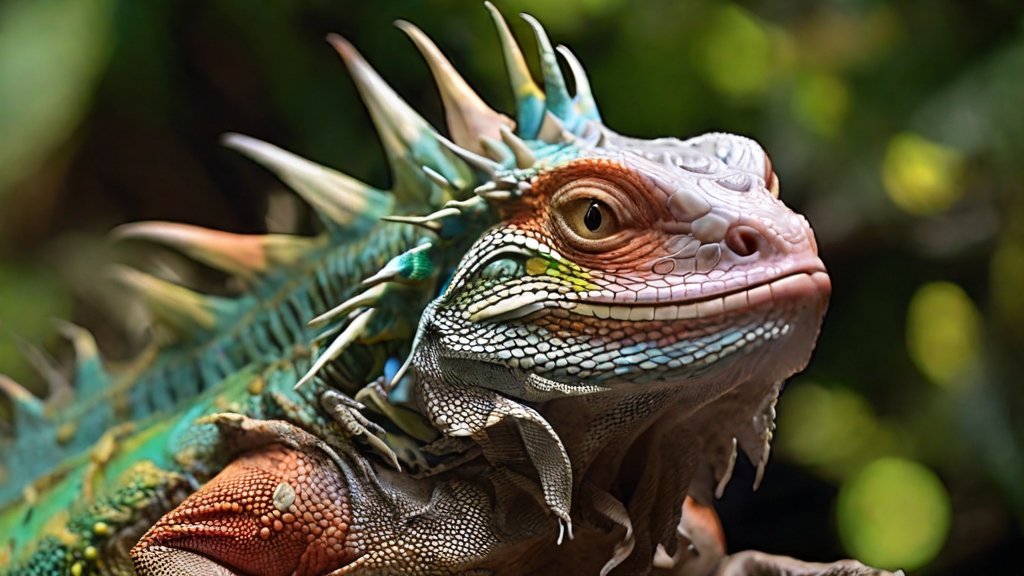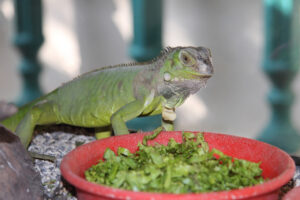Are you struggling to maintain a garden while dealing with pesky iguanas munching on your plants? Fear not! In this comprehensive guide, we will explore the world of plants that iguanas simply refuse to eat.
With years of experience and expertise, we have gathered information from authorities in the field, ensuring that you can trust our recommendations. So, let’s dive in and discover the plants that will keep your garden safe from hungry iguanas.
Understanding Iguana Feeding Habits
Before we delve into the plants that iguanas will not eat, it’s essential to understand their feeding habits. Iguanas are herbivorous reptiles, meaning they primarily feed on plant matter. Their diet consists of leaves, flowers, fruits, and even bark.
However, not all plants appeal to their taste buds. Certain native and non-native plant species have shown resistance to iguana consumption, providing a solution for garden enthusiasts seeking to protect their greenery.
Native Plants Resistant to Iguana Consumption
When it comes to planting iguana-resistant species, native plants are an excellent place to start. Native plants have evolved alongside iguanas and have developed natural defenses against them. These plants often possess unique characteristics, such as tough leaves, strong odors, or even toxins, which deter iguanas from feasting on them.
By incorporating native plants into your garden, you can create a harmonious environment that both supports local ecosystems and keeps iguanas at bay.
Exploring Native Plant Species
Native plants known for their resistance to iguana consumption include the Gumbo Limbo tree, the Simpson’s stopper shrub, and the Coontie palm. These plants not only provide visual appeal but also serve as a barrier against iguana invasion.
The Gumbo Limbo tree, scientifically known as Bursera simaruba, features thick bark that iguanas find unappetizing. Similarly, the Simpson’s stopper (Myrcianthes fragrans) emits a strong aroma that repels iguanas.
Coontie palms (Zamia pumila) contain toxins that make them an unattractive food source for these reptiles. By incorporating these native plants into your garden, you can create a beautiful landscape that iguanas will avoid.
Non-Native Plants Unappealing to Iguanas
While native plants are a reliable choice, non-native plant species can also be effective in deterring iguanas from your garden. These plants, although not naturally found in the iguanas’ habitat, possess characteristics that make them unappealing to these reptiles.
By introducing non-native iguana-resistant plants, you can expand your options and add variety to your garden while ensuring your plants remain untouched by these voracious eaters.
Introducing Non-Native Iguana-Resistant Plants
Non-native plants such as the Crown of Thorns (Euphorbia milii), the Spider Lily (Hymenocallis latifolia), and the Ruellia (Ruellia brittoniana) have shown resistance to iguana consumption. The Crown of Thorns is an attractive, thorny plant that iguanas tend to avoid due to its prickly nature.
The Spider Lily, also known as the “Peruvian Daffodil,” features beautiful white flowers with a strong scent that repels iguanas. Ruellia, commonly referred to as Mexican petunia, produces showy purple flowers but contains compounds that make it unpalatable to iguanas.
By incorporating these non-native plants into your garden, you can ensure that your greenery remains untouched by iguanas.
Factors Influencing Iguana Food Preferences
Understanding the factors that influence iguana food preferences can help you make informed decisions when selecting plants for your garden. Several environmental and behavioral factors come into play when it comes to what iguanas choose to eat.
Examining Environmental and Behavioral Factors
Iguanas are more likely to consume plants that are easily accessible, within their preferred temperature range, and readily available in their habitat. They also tend to avoid plants with strong odors, thick leaves, or toxic compounds.
Furthermore, iguanas have individual preferences, and their tastes may vary based on factors such as age, sex, and reproductive status. By considering these environmental and behavioral factors, you can make strategic choices when selecting plants that iguanas will not eat.
Creating an Iguana-Proof Garden
Now that we have explored the types of plants iguanas tend to avoid, it’s time to discuss effective planting strategies to create an iguana-proof garden.
Implementing Effective Planting Strategies
One effective strategy is to create barriers around your garden using fences, netting, or plant cages. These physical barriers can prevent iguanas from accessing your plants. Additionally, planting prickly or thorny plants as a first line of defense can deter iguanas from entering your garden.
Mulching with materials like gravel or rocks can also discourage iguanas from venturing into your garden, as these surfaces are uncomfortable for them to walk on. By implementing these planting strategies, you can create a garden that is unappealing and inaccessible to iguanas.
Key Considerations for Iguana Deterrence
While planting iguana-resistant species and implementing effective planting strategies are crucial, incorporating natural repellents and barriers can further deter these reptiles from invading your garden.
Incorporating Natural Repellents and Barriers
Natural repellents such as garlic spray, hot pepper spray, or predator urine can be applied to plants to discourage iguanas. These odors are typically unappealing to them and can help protect your greenery.
Additionally, installing motion-activated sprinklers or ultrasonic devices can startle iguanas and encourage them to seek another location. By incorporating these natural repellents and barriers, you can create an environment that iguanas will want to avoid.
Ensuring the Health of Iguanas and Plants Alike
While it is essential to protect your garden, it is equally important to ensure the well-being of iguanas and maintain a balanced ecosystem.
Promoting a Balanced Ecosystem
Remember, iguanas play a vital role in their natural habitats. To promote a balanced ecosystem, provide alternative food sources for iguanas in designated areas away from your garden. Planting vegetation such as hibiscus, mango trees, or even specific flowering plants can entice iguanas away from your prized plants. By offering alternative food sources, you can coexist harmoniously with these reptiles while safeguarding your garden.
Conclusion
In conclusion, by selecting native and non-native iguana-resistant plants, implementing effective planting strategies, and incorporating natural repellents and barriers, you can create an iguana-proof garden that remains lush and untouched.
However, it is crucial to remember that while protecting your garden, it is equally important to promote a balanced ecosystem and respect the role iguanas play. So embrace the harmony between iguanas and gardens, and enjoy the beauty of a thriving and iguana-free landscape.




